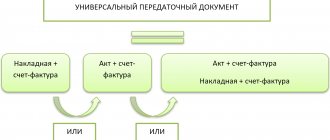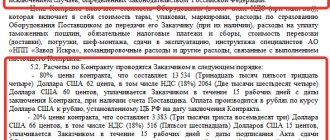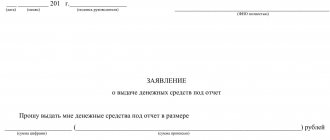Why is it necessary when selling?
When selling products, the supplier is obliged to present the amount of VAT tax for payment to the buyer (Article 168 of the Tax Code of the Russian Federation). An invoice is a document certifying the fact of sale of goods, as well as its cost. It is necessary to confirm the amount of VAT both on sales of products and to confirm the fact of purchase and incoming VAT.
More details about why an invoice is needed can be found here.
Invoices and invoices - what they are and when they are used
In order to understand what it is - an invoice and an invoice, you must first understand the definitions.
Invoice is a document issued for international deliveries. It is often called an invoice, but in essence it does not at all correspond to the invoice that Russian accounting operates. What is the difference between an invoice and an invoice based on?
According to the rules in force in Russia, an invoice is a document that arises when carrying out transactions subject to VAT and is intended to justify the deduction of the tax amount indicated in it. It is drawn up by the seller, and all invoices issued during shipment are reflected in the sales book, the result of which corresponds to the amount of tax accrued for the period to be paid to the budget. He has the right to reduce this amount by the amount of tax charged to him by suppliers (this amount will be generated by the seller in the purchase book), provided that the suppliers have received invoices with allocated VAT.
Thus, an invoice for Russian accounting is a tax accounting document maintained for the purposes of calculating VAT paid to the budget or reimbursed from it based on the results of such calculation for the tax period. He also justifies the legality of the accounting entry Dt 68 Kt 19, which records in accounting the acceptance of the tax billed by the supplier as deductions. The invoice used in Russia does not have any other functions. Since its registration is directly related to shipment, it is included in the set of shipping documents issued for Russian buyers.
The invoice, which is used when processing international shipments (including deliveries both to and from Russia), plays a completely different role. It contains a description of the goods sent to the buyer, indicating its volume, cost, packaging and delivery features.
You can see the invoice form in ConsultantPlus. If you do not already have access to this legal system, a full access trial is available for free.
That is, in terms of its content, the invoice corresponds to a document that in Russian accounting practice is defined as a waybill. If it is drawn up in relation to services, then its contents correspond to the certificate of work/services performed within Russia.
At the same time, the invoice acts as an invoice issued for payment. However, such a function arises for him only if the delivery has not been prepaid.
In translation, the word “invoice” is usually referred to as “invoice, invoice” (which fully corresponds to the two different functions it performs), but the proximity of these two meanings in translation leads to an erroneous combination of them into the combination “invoice”, which is familiar to Russia.
What information should be included?
To include an invoice in tax accounting, you must provide the following information:
- Issue number and date.
- Details of the supplier and buyer (name, tax identification number, checkpoint, address).
- Name and address of the consignee and shipper.
- Number of the payment and settlement document in case of acceptance of the advance.
- List of goods, unit of measurement (if it is possible to indicate it).
- Quantity of goods indicated on the invoice.
- Name of currency (No. 229-FZ dated July 27, 2010), (643 – Russian ruble, 840 – US dollar, 978 – euro).
- Price per unit of measurement excluding tax.
- The cost of the total quantity does not include tax.
- Excise duty amount for excisable products.
- Tax rate (0%, 10%, 18%).
- The amount of tax charged to the buyer according to the applicable tax rates.
- The cost of the total quantity, taking into account the amount of tax.
- Country of origin of the product.
- Customs declaration number (DT).
How to make an invoice for a foreign company for services
An invoice, or invoice, is a commercial document issued to a buyer by a seller and containing information such as the price and quantity of goods, methods of payment and the maximum period within which the buyer must make payment. A seller is a provider or performer of services; and the buyer is the customer or client.
This document is important for both parties, since the seller needs a copy of it for record keeping, and the client needs to have a copy of it to record the purchase. If you issue an invoice, it means someone owes you.
If you receive a bill, it means you owe someone. Even though
What is an invoice and why is it needed?
In any case, it should contain:
- a list of the goods being sent with a description of its characteristics: quantity, volume, weight, purposes of use, price, etc.
- the same data about the recipient organization,
- details of the sending company (its full name and address),
The more complex or expensive the item being sent, the more carefully and in detail it should be described.
How to invoice a foreign company for the provision of services?
If we talk about an individual, then it’s 13% and that’s it, there are no contributions.
Nothing. August 31, 2021, 10:58 am Was the lawyer's response helpful? + 1 — 0 220 lawyers are ready to answerResponse on the website within 15 minutes Ask a question
- 7.8 rating
- 35% fee received Lawyer, Kemerovo Chat
Good afternoon Or maybe there are some other options?Of course, I would like something simple, so as not to bother with reporting, etc., since we are not talking about such a big income. Ekaterina As an option to conclude an agreement for the provision of services for a fee: art.
779 Civil Code of the Russian Federation: 1.
Under a contract for the provision of services for a fee, the contractor undertakes, on the instructions of the customer, to provide services (perform certain actions or carry out certain activities), and the customer undertakes
Invoice for payment to a foreign company
An invoice is a document used exclusively for tax control purposes and therefore cannot be considered an analogue of an invoice.
In this regard, in Russia an invoice is usually used for international deliveries of goods. In its accounting and legal essence, the invoice is more likely to correspond to the document “Service Acceptance Certificate” (for) than to the “Invoice for payment”.
In the Description column you must indicate a detailed description of the work/products/services.
You should also indicate the quantity
Rules for filling out an invoice when importing goods
When purchasing a foreign product, the seller issues an invoice for payment called INVOICE.
In the practice of foreign economic activity, the transcription name has been established - INVOICE. There is a document called proforma invoice.
This document is issued by the seller as a preliminary invoice for making an advance payment for the goods. But with the goods there is a document that is the final invoice, called an invoice. The invoice is the main document for confirming the value of the goods to the customs authorities.
And its accuracy and significance when monitoring the declared customs value directly depends on the correctness of its completion. Below are the basic information that must be included in the invoice:
- date and invoice number
- details of the seller and buyer with bank account details
- terms of delivery of goods, in accordance with the current edition of INCOTERMS
- terms and conditions of payment for goods
- number and date of the contract and specifications in accordance with which the goods are supplied
- name of the product, its articles, serial numbers and other relevant information
- product code according to
- quantity of goods, its weight and cost
- country of origin of the goods
- name of the product manufacturer
- signature of the seller indicating the full name and position of the person who signed the document
- seller's stamp
The availability of the specified data is controlled by the customs authorities during customs clearance. It is advisable to issue the invoice on the seller’s letterhead. The person who signed the contract must sign the invoice.
This will help you avoid many problems at customs. Good luck with customs control! You can find additional information on the topic in the section. Free consultation by phone: +7 (the call is free) Attention!
Due to recent changes in legislation, the legal information in this article may be out of date! Our specialist will advise you free of charge.
Wordhord
Information about the services provided:
- price per word (page, etc.)
- total amount due
- number of words (pages, etc.)
- order cost
- order number (assigned by the employer)
- file names, translation direction, etc.
6. Payment Terms: Specify when payment is due.
This is agreed upon with the employer in advance. Payment is usually due 30 days after the invoice is issued.
But in practice it turns out to be from 35 to 60 days, because...
some companies only make payments at the end of the next month. If you agreed to pay by bank transfer, then please provide your account details.
Services for a foreign company – how to issue an invoice correctly?
By virtue of the provisions of the current Agreement, a foreign buyer (resident of Lithuania) is not required to withhold tax levied under Lithuanian law.
What types are there?
For export
Reference! Export refers to the removal of goods outside the country for sale in foreign markets.
Exports are subject to VAT at a rate of 0% (Article 164 of the Tax Code of the Russian Federation). This tax rate should be confirmed by providing the appropriate package of documents within 180 calendar days from the date of export of goods under the customs export regime.
This package provides:
- contract with a foreign counterparty;
- customs declaration;
- accompanying documents for products and transport with customs marks.
If the buyer is a Russian company, then the 0% VAT rate is prohibited. After 180 days, the sale of exports is not reflected in the VAT return. The export invoice is issued in one copy, since the buyer does not need to provide it.
The 0% rate is indicated in the “tax rate” column, and a zero amount is indicated in the “tax amount” column. If the documents have not been submitted to the tax authorities within the prescribed period, then it is necessary to issue an invoice with a tax rate of 10% or 18%.
Important! When exporting goods, the tax rate is 0%.
For import
Import of goods means the import of imported products produced outside the country into which they are imported for the purpose of consumption or resale. There is no need to issue an invoice for imports. This is due to the fact that an invoice is a document with which the seller presents the buyer with VAT accrued under Russian legislation (Article 169 of the Tax Code of the Russian Federation).
Obviously, a foreign supplier cannot present such VAT, and therefore does not have the opportunity to issue an invoice. When importing, VAT is paid at customs, and the basis for the deduction is the customs declaration (Article 171 of the Tax Code of the Russian Federation).
When importing goods, an invoice is not issued, but below you can see a sample of the invoice containing the imported goods.
What documents accompany a transaction with a foreign organization?
In domestic trade, the basis for the provision of services or the supply of goods is a contract, payment is made according to an invoice, and supporting documents are an act, an invoice, a UPD, a goods or waybill - depending on whether services are provided or goods are supplied. The rules for maintaining these documents, both in paper and electronic form, are enshrined in legislation and are regularly updated.
In the case of foreign trade, accounting deals with a completely different set of documents. The basis of international trade relations between two organizations is a contract , which must be drawn up in two languages - the languages of the subjects of trade relations for an unambiguous interpretation of all its terms by both parties. Formally, there are not many differences between a contract and an agreement; sections of the documents are identical.
But with supporting documents, not everything is so clear. In foreign legislation there are no concepts of invoices, invoices, acts and UPD . Some counterparties agree to sign acts of any form drawn up by Russian partners in order to accept them for accounting, but they cannot be obliged to do this.
The main document when working with a foreign company, confirming the supply of goods or provision of services, is an invoice, which is also the basis for making a payment . To deliver goods and clear customs, in addition to the invoice and contract, other accompanying documents must be attached to the cargo:
- packing list;
- bill of lading (for transportation by sea);
- railway waybill (for transportation by rail);
- certificate of origin;
- customs declaration;
- certificates and permits for the import of goods (depending on the imported cargo);
- other accompanying documents that are required according to the legislation of the Russian Federation for the import of certain types of goods.
Documents for inventory items
Upon shipment
Shipment means the transfer of material assets by the seller directly to the buyer , or to the carrier with further transfer to the buyer. To accompany this transaction, a standard invoice is issued in a standard form (clause 5 of Article 169 of the Tax Code of the Russian Federation), and in case of receipt of an advance payment for the goods, an advance invoice is issued, which indicates the number of the payment document (clause 5.1 of Article 169 Tax Code of the Russian Federation).
When selling
The basis for the sale of goods is an agreement (contract) for the purchase and sale of products. A sales contract is a written agreement between two parties to transfer products at an agreed price. A significant condition of this transaction is the price for the goods.
A purchase and sale agreement involves the transfer of funds at the time of conclusion, in contrast to a supply agreement, when payment can be made upon sale. Accordingly, for a transaction for the sale of products, either a standard invoice of a standard form or an advance invoice can be issued in the case of receiving an advance payment.
Upon delivery
Delivery means a transaction under which the seller undertakes to transfer the goods to the buyer within a certain period of time, and the buyer to accept and pay in accordance with the terms of the contract. Delivery is carried out by shipment, i.e. delivery of goods directly to the buyer or the recipient specified in the contract.
Thus, shipping is a mode of delivery, i.e. its main element, so there are no significant differences between them. The delivery of goods, as well as the shipment, are documented using similar documents.
What is an invoice and what can its sample be like?
The invoice must include the following information:
- the date of its preparation;
- full name (or full name) and address of the seller and buyer of the goods;
- similar data of the recipient, if he is present as an intermediate link between the seller and the buyer;
- names of three countries: the manufacturer of the goods, the sender and the recipient;
- transportation document number;
- details of the supply contract or other document that became the basis for shipment;
- delivery conditions;
- bank details for payment and deadlines for making payment (for shipments made without prepayment);
- information about the currency in which prices and costs are indicated, and about the rate used for conversion, if payment for the delivery has yet to be made and will be made in a different currency;
- a description of each product item, indicating the corresponding number of units, listing special characteristics, describing the type and weight of packaging and the number of resulting items, indicating the price per unit and the total cost of the item.
The generated document must be carefully checked (the absence of errors and inaccuracies in it guarantees quick border crossing) and certified by the sender’s signature.
Unlike an invoice that has a legally approved form, it is quite difficult to provide a sample of an invoice. It does not have a specific form. Each sender of cargo develops its own form for it, taking into account the peculiarities present in the conditions of its deliveries. Therefore, an invoice can look like a table or a text document with data grouped thematically in it. One of the tabular versions of the invoice form can be viewed on our website:
Filling out is usually done in English. For ease of registration by the Russian side, it is recommended that the English names of each of the invoice items be accompanied by a translation into Russian.
Who should exhibit?
Invoices are issued only by VAT payers. Enterprises that use simplified taxation systems (USN, UTII) may not issue invoices.
Read more about who issues the invoice here.
How is it filled out?
The invoice form is filled out strictly in the form established by the Legislation of the Russian Federation, in compliance with all requirements (Article 169 of the Tax Code of the Russian Federation). Deviation from the requirements may be grounds for denial of a tax deduction.
- The document can be filled out either by hand or using special programs.
- The form must indicate:
- details of the supplier and buyer;
- a complete list of supplied products;
- price;
- quantity;
- information about the VAT rate.
Who signs and how?
The invoice is certified by the head and chief accountant of the organization that issues it . If the company does not have the position of chief accountant, and this is confirmed by relevant documents, the document will be signed only by the manager. Signatures must be original; facsimiles are prohibited. A seal is not required.
How to register?
To register invoices, the law provides for: an accounting journal, a purchase book and a sales book.
- At the time of issuing or receiving invoices, the data is reflected in the accounting journal, outgoing invoices are registered by the date of their issuance, incoming invoices by the date of receipt.
- Invoices are entered into the sales books at the time of shipment of goods, in all cases when the obligation to calculate VAT arises.
- Invoices received from sellers are included in the purchase ledger as the right to VAT deductions arises.
VAT when foreign organizations provide services in electronic form
From 2021, “foreigners” must register with the tax authorities of the Russian Federation and independently calculate and pay VAT to the Russian budget. In addition, a foreign seller is required to submit a VAT return quarterly.
Instead of a foreign company, any intermediary of a “foreigner” (also a foreign company) who provides electronic services on its behalf can register. Such an intermediary is recognized as a tax agent. It is registered, pays tax and submits a declaration in the same manner as a foreign company providing electronic services to citizens (Clause 4.6 of Article 83 of the Tax Code of the Russian Federation).
Which Internet services are subject to VAT?
VAT is subject to the following services of foreign Internet companies (clause 1 of Article 174.2 of the Tax Code of the Russian Federation):
- sale of computer programs, applications, games and databases, including updates to them;
- advertising services on the Internet and provision of advertising platforms;
- online auctions;
- platforms for posting offers for the sale of goods and services;
- data storage;
- hosting provider services;
- domain registration;
- digital goods (providing rights to digital books, music, audiovisual products, graphic images);
- administration of information systems and Internet sites;
- storage and processing of information, provided that the person providing the information has access to it via the Internet;
- searching and presenting information about potential buyers;
- access to Internet search engines;
- website visit statistics, etc.
VAT deduction for electronic services
The tax base for VAT for the provision of electronic services is defined as the cost of these services, taking into account the amount of tax, calculated on the basis of actual sales prices (clause 2 of Article 174.2 of the Tax Code of the Russian Federation). The foreign seller will have to calculate the tax at an increased rate – 16.67%.
To obtain a VAT deduction, a Russian buyer will need the documents specified in paragraph 2.1 of Article 171 of the Tax Code:
- agreement and (or) payment document highlighting the VAT amount and indicating the TIN/KPP of the foreign organization;
- documents for the transfer of payment to a foreign organization, including the amount of VAT.
In such a situation, an invoice is not needed for deduction. Foreign companies themselves do not have the right to deduct VAT and do not have to draw up this document for their services. How to keep books of purchases, sales, as well as journals of invoices (clause 3.2 of Article 169 of the Tax Code of the Russian Federation).
Please keep in mind: deductions of VAT amounts claimed by foreign organizations for other services, the place of sale of which is recognized as the territory of the Russian Federation, are made in accordance with the general procedure. That is, for the deduction you will need invoices issued by such foreign organizations.
Federal Tax Service on filling out the purchase book
If an organization purchases electronic services from a foreign company or from its intermediary - a foreign organization, the Federal Tax Service of Russia in its commented letter recommends that it fill out the purchase book as follows:
- in column 2 – transaction type code 45;
- in column 3 - the number and date of the agreement or payment document (invoice for payment of services, act of provision of services or other document of a foreign organization). They must contain the foreigner’s tax identification number and checkpoint, as well as the amount of VAT;
- in column 7 - the number and date of the payment, and for non-cash forms of payment - the number and date of the document that indicates the repayment of the debt.
Let us remind you that information from the purchase book will be reflected in section 8 of the VAT return.
About the shopping book
The purchase ledger records invoices received by the company from suppliers. Its form was approved by Decree of the Government of the Russian Federation dated December 26, 2011 No. 1137 (hereinafter referred to as Resolution No. 1137), and the format for preparation in electronic form was approved by Order of the Federal Tax Service of Russia dated April 6, 2018 No. ММВ-7-6/ [email protected]
The basic principle of filling out the purchase book is this: documents need to be registered in the book when the company uses VAT deductions.
Organizations and entrepreneurs exempt from paying VAT in accordance with Article 145 of the Tax Code of the Russian Federation may not maintain a purchase book. This is due to the fact that these persons do not have the right to deduct tax amounts.
Supplier invoices are recorded in the purchase ledger if the following conditions are met:
purchased assets (work, services) were acquired for operations subject to VAT and capitalized;
the invoice is drawn up in the prescribed form and filled out in accordance with the rules set out in Resolution No. 1137.
Invoices, adjustment and corrected invoices received on paper or electronically are registered in a uniform manner as the right to tax deductions arises (Article 172 of the Tax Code of the Russian Federation).
In the purchase book you need to register tickets, hotel bills and other strict reporting forms that confirm expenses for employee business trips. It is only necessary that the VAT amount be highlighted in these documents and that they are included by the employee in the business trip report.
The principal registers invoices received from the commission agent in the purchase ledger. This applies to invoices issued by the commission agent for the amount of his remuneration. When transferring an advance to a commission agent for the upcoming provision of services, the principal must also register an invoice from the commission agent in the purchase book.
Buyers register in the purchase book invoices received from sellers when transferring an advance against the upcoming delivery of goods. When receiving an advance, sellers issue invoices and register them in the sales book (including non-cash payments).
The purchase book is signed by the head of the organization or another authorized person. By the 20th day of the month following the expired quarter, its sheets must be numbered, laced and sealed with the company's seal. It is stored in the organization’s archives for at least four years from the date of the last entry. If you keep a purchase book in electronic form, then it must be signed with an enhanced qualified electronic signature, but only when transferred to the Federal Tax Service via TKS (including as part of a desk audit).
Expert “NA” E.V. Natyrova
| REGULATIONS FOR ACCOUNTANTS Electronic version of the popular magazine New documents with expert comments. The magazine helps accountants understand the meanings and implications of new accounting and tax documents. Subscribe |










